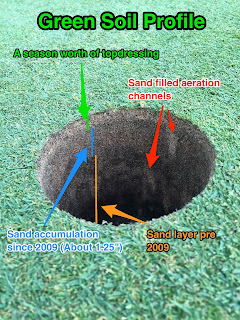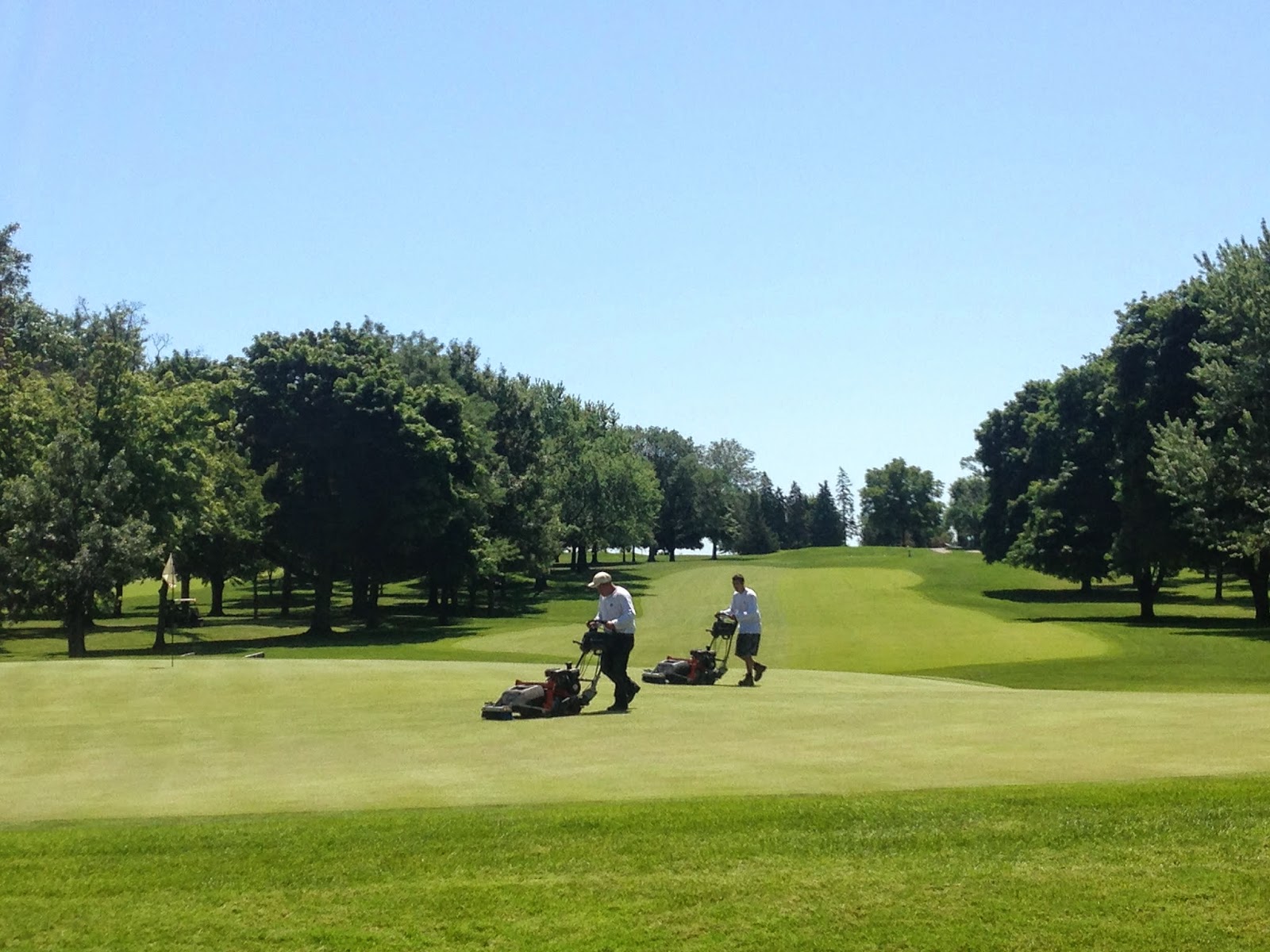Sand - Not Just for Bunkers
It should not be a secret that I love sand. At the end of our maintenance days, I sometimes judge productivity by the amount of sand that pours out of my shoes. Sand topdressing is one of the components for a strong foundation to a sound agronomic plan for maintaining high quality playing surfaces. With this post, I'll dive into why sand is so important for a golf course.
Understanding sand on grass can be a nuisance from time to time, the benefits far outweigh the negatives and while I could explain the reasons for, here is an article from the USGA Green Section that does a much better job.
While the article above mainly focuses on putting greens (which ours are treated the same as in the article), the same principles are applied to other areas of finely cut turf such as approaches, fairways, and tees. Over the last 8-10 years, we have been topdressing our approaches to mainly firm, drain, and smooth the surface. It has been very fun to see more shots bounce up onto the green that previously would have plugged in the approach. I have also noticed a wider variety of shots played from collection areas or lies just off the green than before. Putters are now as common as wedges for players. Our sand topdressing coupled with other cultural practices has made these surfaces more consistent.
With this background information about the impacts of sand on short cut turf, the discussion can move to fairways. For the same reasons we topdress greens, approaches and tees is why we started to add sand to fairways. Another added benefit of sand is reducing the activity of earthworms at the surface. In the spring and fall earthworms are most active at the surface. They are also beneficial to the health of our course and do plenty to help break down organic matter (OM) and aerate our soils. The result of their work creates a nuisance to the playability of our fairways causing unfavorable lies since they bring soil to the surface that gets smeared when we mow. While topdressing reduces the occurrence of casts, it will take a while until enough sand is built up to have an effect.
Timing and rates of sand applications to fairways revolves heavily around the events calendar since it simply takes time to spread sand. Our goal is to make frequent enough applications to match growth without prolonged time lapses between applications to avoid inviting new agronomic issues. Fortunately, weather has cooperated with our maintenance days and I feel we are in a good place with the timing of our applications. For the couple times this year we had 4 or 5 weeks without a maintenance day, we had to adjust our rates (heavier) to make up for and get ahead of the calendar.
As the season progresses and we move beyond our Monday outings, we will have plenty of time come September to not have as much impact on your golf experience. You have also probably noticed the appearance of our fairways has changed too. We no longer have long leggy growth and now have a tighter canopy that helps the ball stand up a little taller. Another benefit is faster divot recovery following an application since sand build up buries the crown of the plant. I'm rather pleased with the progress we have made so far this season and will only see further improvement.
If you would like some more reading about topdressing fairways, here is another article from the USGA.
Now you know why I love sand. The secret is out and hopefully you love sand a little more too or can understand why there might be a little sand on the surface from time to time. Sand on grass will always be better than that found in a bunker, so at least we have that going for us, which is nice.
Understanding sand on grass can be a nuisance from time to time, the benefits far outweigh the negatives and while I could explain the reasons for, here is an article from the USGA Green Section that does a much better job.
 |
| Who ever thought there could be so much involved below the surface? |
While the article above mainly focuses on putting greens (which ours are treated the same as in the article), the same principles are applied to other areas of finely cut turf such as approaches, fairways, and tees. Over the last 8-10 years, we have been topdressing our approaches to mainly firm, drain, and smooth the surface. It has been very fun to see more shots bounce up onto the green that previously would have plugged in the approach. I have also noticed a wider variety of shots played from collection areas or lies just off the green than before. Putters are now as common as wedges for players. Our sand topdressing coupled with other cultural practices has made these surfaces more consistent.
 |
| Few sights are more pleasing to my eye than a topdressed fairway |
With this background information about the impacts of sand on short cut turf, the discussion can move to fairways. For the same reasons we topdress greens, approaches and tees is why we started to add sand to fairways. Another added benefit of sand is reducing the activity of earthworms at the surface. In the spring and fall earthworms are most active at the surface. They are also beneficial to the health of our course and do plenty to help break down organic matter (OM) and aerate our soils. The result of their work creates a nuisance to the playability of our fairways causing unfavorable lies since they bring soil to the surface that gets smeared when we mow. While topdressing reduces the occurrence of casts, it will take a while until enough sand is built up to have an effect.
 |
| Castings on a fairway. Some ask me if I aerated fairways when it was actually worms! |
 |
| Close up of a smeared casting. |
 |
| Photo taken 4/4/17 |
As the season progresses and we move beyond our Monday outings, we will have plenty of time come September to not have as much impact on your golf experience. You have also probably noticed the appearance of our fairways has changed too. We no longer have long leggy growth and now have a tighter canopy that helps the ball stand up a little taller. Another benefit is faster divot recovery following an application since sand build up buries the crown of the plant. I'm rather pleased with the progress we have made so far this season and will only see further improvement.
If you would like some more reading about topdressing fairways, here is another article from the USGA.
Now you know why I love sand. The secret is out and hopefully you love sand a little more too or can understand why there might be a little sand on the surface from time to time. Sand on grass will always be better than that found in a bunker, so at least we have that going for us, which is nice.

Comments
Post a Comment